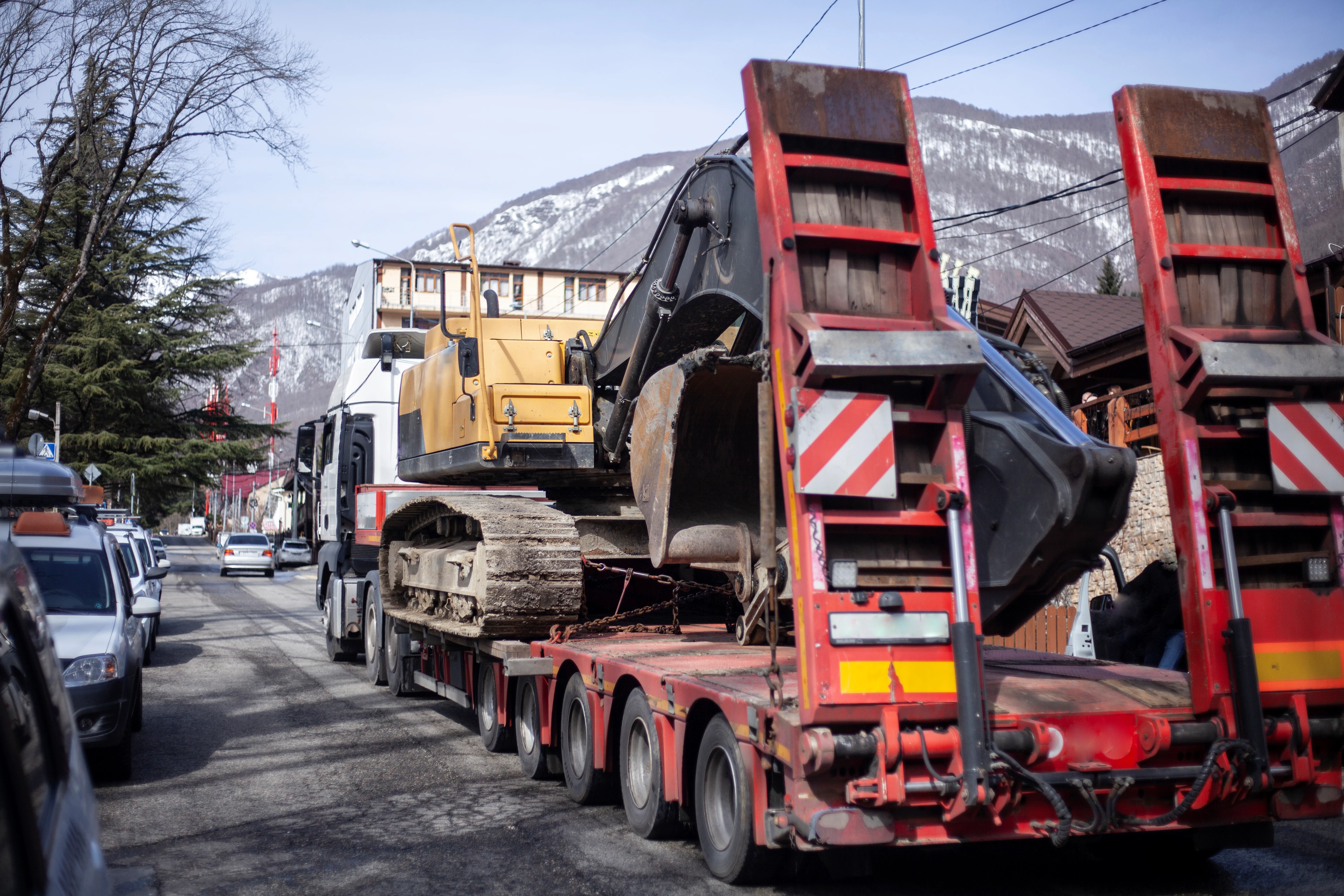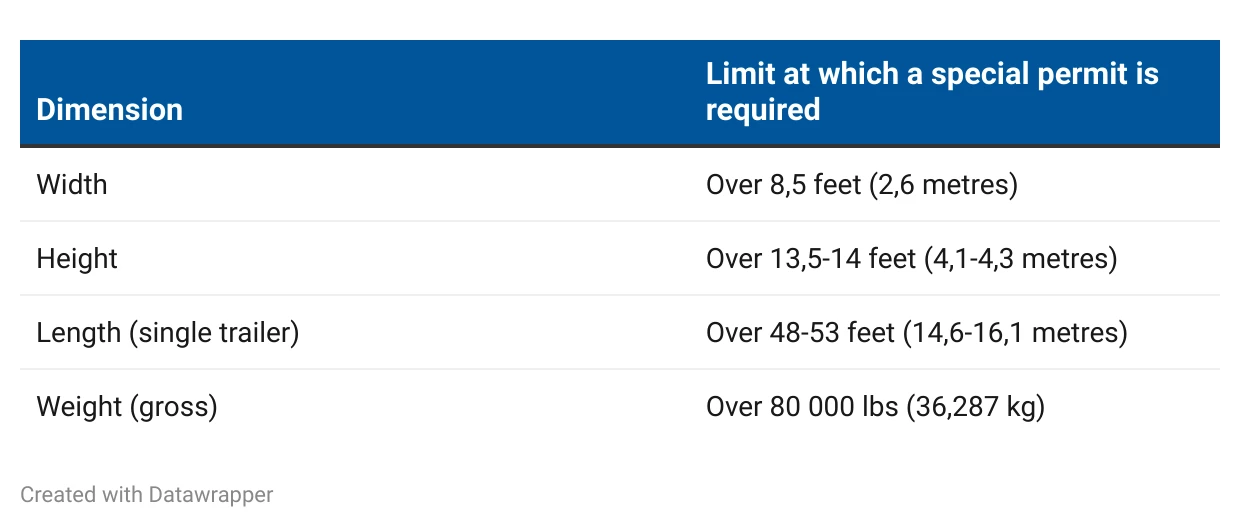Need to transport large or heavy loads? We're talking about things like wind turbine blades, construction equipment, or power station generators. This is where heavy haulage comes in.
In this guide, we'll explain what heavy haulage in transport is, how it operates, the specialized equipment used, the regulations you need to follow, and the best practices to keep everything running smoothly and safely.
What is heavy haulage?
Heavy haulage refers to the transportation of cargo that surpasses the usual legal limits for size, weight, or height. These types of loads cannot be carried by standard trucks and require specialized equipment, route planning, and permits to ensure safe and legal transportation.
So, what does haulage mean?
Haulage refers to the transportation of goods, typically over long distances, using vehicles such as trucks, lorries, or trailers. It often involves the movement of large, bulky, or heavy items. The term can also refer to the business or industry involved in the transport of freight.
What is heavy haul trucking?
Heavy haul trucking is another word for the transportation of oversized or heavy loads that exceed the standard legal size or weight limits for regular trucks. These loads can include large machinery, construction equipment, industrial materials, or other bulky items.
To accommodate these oversized loads, heavy-haul trucking typically involves specialized equipment, such as flatbed trailers, multi-axle trailers, or custom rigs. Additionally, permits are often required for such transport, and the routes may need to be planned carefully to avoid obstacles like low bridges or narrow roads.

General limits for heavy haulage
Although regulatory limits can differ by location, there are typical limits that require a heavy haulage solution. If your load exceeds these general dimensions, special regulations apply.

Note! — These limits can differ by country, state, or even specific roads. Additionally, logistics providers may have varying specifications. Always review local regulations before planning a heavy haulage transport.
Industries that rely on heavy haul services
Heavy haul trucking plays a crucial role in industries that require the transport of large, heavy, or uniquely shaped equipment, such as:
- Construction: Cranes, bulldozers, and prefabricated structures
- Energy and utilities: Transformers, turbines, generators, and reactors
- Oil and gas: Drilling rigs, pipelines, and offshore equipment
- Manufacturing: Oversized industrial machinery
- Wind energy: Blades, towers, and nacelles
- Aerospace: Aircraft fuselages and components
Heavy haulage in 5 steps
The heavy haul trucking process involves five steps that require careful planning and coordination. Let´s walk you through them.
- Planning and permits: The journey begins with obtaining the necessary permits, selecting the right equipment, and determining the best route for the cargo.
- Route planning: A detailed route is created, factoring in clearance heights, bridge weight limits, local regulations, and potential obstacles.
- Loading and securing: Specialized cranes or forklifts are used to load the cargo, which is then secured with heavy-duty tie-downs to prevent shifting during transit.
- On the road: The vehicle follows the planned route, often with escort vehicles if required by the permit or route plan, ensuring safe and legal transport. This step can include additional work such as removal of obstacles, signs etc. as well as extra road work to strengthen the roads load-bearing qualities.
- Unloading and delivery: Upon reaching the destination, the cargo is unloaded using the proper lifting equipment to ensure a safe delivery.
What does heavy hauling cost?
The cost of heavy hauling can vary significantly based on different factors. Let’s go through them.
- Permits: The cost of permits varies depending on the state, country, or region, and is determined by the weight and dimensions of the load. Larger or heavier loads require more permits, which can drive up the cost.
- Fuel: Due to the size of the vehicle and the weight of the cargo, fuel consumption is significantly higher for heavy hauling. This results in increased fuel costs, especially for long-distance transport.
- Pilot/escort vehicles: If the load is exceptionally large or the route is particularly complex, multiple pilot or escort vehicles may be required. This adds extra costs for each vehicle involved in ensuring safe transport.
- Skilled labor: Heavy hauling requires to be experienced, certified drivers and riggers to ensure safe and efficient transport. The cost of hiring skilled professionals adds to the overall expense of the move.
Learn how to calculate shipping costs
How is heavy haulage different from project logistics?
Heavy haulage and project logistics are often mixed up, but they serve different purposes:
Imagine the construction of a new factory. Heavy haulage would focus on transporting large, heavy equipment like machines or boilers needed for production.
Project logistics, however, would involve the entire process of planning, organizing, and coordinating the transport of all materials and resources – everything from steel beams and cement to smaller tools – ensuring they arrive at the right time, in the right sequence, and at the right location for efficient construction.
While heavy haulage deals with the heavy and oversized components, project logistics covers the full scope of planning and delivery for a project.
Is heavy haulage ever intermodal or multimodal?
Heavy haul shipments don’t always rely solely on road freight. Often, they are part of an intermodal or multimodal transport system, where different methods of transportation are combined to move the load. Common combinations include:
- Truck + Rail: Rail freight combined with road transportation is ideal for long inland journeys, where heavy or oversized cargo is transported on specialized railcars, with trucks handling the first and last mile.
- Truck + Barge: On inland waterways, barges efficiently transport very heavy or out-of-gauge cargo, with trucks managing transport at the start and end of the journey.
- Truck + Ocean: For international shipments, trucks transport the cargo to ports, where it’s loaded onto roll-on/roll-off or break bulk vessels for ocean freight.
By combining different transport modes, it’s possible to reduce costs, bypass infrastructure limitations, and create more efficient logistics for oversized shipments.
Not sure which solution to choose? Read: Which transport solution should you choose?
Need help with your heavy haul cargo?
Bertling's Route Survey Services are integral to the successful execution of heavy haulage projects, ensuring the safe and efficient transport of oversized and high-value cargo to even the most challenging locations.
Our Route Survey services follow a structured three-phase process to guarantee a safe and timely delivery of project cargo:
- Research: Initial studies utilizing maps, satellite imagery, and local insights to identify potential routes and assess feasibility.
- On-the-ground investigation: Field inspections using specialized equipment like GPS cameras and laser measuring tools to document critical elements such as pinch points, bridge clearances, gradients, and potential obstructions.
- Engineering and report production: Analysis of findings to produce detailed Route Survey reports, offering insights into necessary route modifications, structural improvements, and precise measurements.
With a global network of offices and a dedicated team of heavy-lift engineers, Bertling combines international expertise with local knowledge to navigate the complexities of heavy haulage projects worldwide. Contact us to learn more about how we can support your next project.
FAQ
What is considered a heavy haul load?
A heavy haul load refers to any cargo that exceeds the standard weight or size limits for regular transportation. This typically involves loads that are heavier than 80,000 pounds (ca. 36,287 kg) or larger than typical vehicle dimensions.
What is the difference between haulage and cargo?
- Haulage refers to the act of transporting goods or freight from one location to another. It can also refer to the transportation industry as a whole, which includes the vehicles, operators, and logistics involved in the movement of goods.
- Cargo refers to the actual goods or freight being transported. Cargo can be anything from raw materials to finished products, and it’s the item being moved, while haulage is the process of moving that cargo.
What is a heavy haul truck driver?
A heavy haul truck driver is a professional driver who operates specialized vehicles designed to carry oversized or heavy loads. These drivers are trained to handle complex routes and navigate obstacles, such as low bridges, narrow roads, and restricted areas, while ensuring the safe and legal transport of heavy and oversized cargo. The job often requires special permits and knowledge of regulations specific to heavy haul transport.
What is the heaviest load ever hauled?
The heaviest load ever hauled was the hauling of an oil drilling platform, which weighed approximately 48,000 tons (about 96 million pounds). This occurred in the North Sea, and it involved a specially built transport vessel that carried the enormous load over water.
